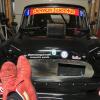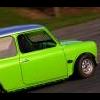I know hub/cv nut torque has been done to death and I think I have read most of it - bear with me.
I am tidying up a friends recently acquired 1963 Cooper 997. It has the 7inch discs but 7.5 inch back plates suggesting that at sometime it had worn the Cooper S 7.5 discs. It also has a servo, probably part of the previous 7.5 upgrade. It runs original 10x3.5 wheels.
I thought it would be a good idea to ditch the 7 inch discs and go 7.5 so have ordered the discs, calipers and drive flanges which I understand is all that is required.
The hubs are marked BTA186/7, consistent with what I understand to be original and the cv joints seem to be the smaller type used on the drum brake Minis and 997/998 Coopers judging by the size of the hub nut at c29mm and the flat washer under the nut.
I hope I have figured all this out correctly - largely from the parts descriptions on Minispares. Unfortunately I don’t have a workshop manual for this age of Mini, mine are much younger which brings me to the point.
With the smaller cv joint what is the correct torque for the hub nut? In the absence of the workshop manual I have read on here that it could be 83nm for ‘Drum brakes’ - then we get into the mega torque numbers for ‘disc brakes’ depending on the number of split pin holes which I am familiar with. The question on my mind is, does ‘drum brakes’ really mean ‘the smaller cv joint irrespective of the number of split pin holes for drum brakes and 997/998 Cooper’? And is the routine still to tighten to the torque then tighten further to the next split pin holes?
And irrespective of the type of wheel bearings? As I understand it standard wheel bearings would have been ball bearings type but I have also learned that taper bearings can be fitted to the same hubs.
it seems to me that the critical item could be the cv joint and whether it is disc or drum; ball or taper, they may not be the defining issues.
Sorry for the long winded question, you can tell I am confused! Put me straight please!
















